September 30, 2010
Fanapt: Deconstructing A Promotional Slide Deck

Lesson 1: it's pronounced (fa NAPT.) I know, I know.
The intention here isn't to catch Big Pharma in a lie, but to show the data for Fanapt while also showing you the "behind the slides" context. I've done something similar for Geodon and Seroquel (multiple times.)
Some of this material overlaps with the otherst, but I've repeated it here so it could stand alone.
I made these slides mostly from memory or from the PI using MS Paint. They appear different/more professional in the promotional materials, I can assure you.
-------
First, an apocryphal story: Fanapt was named after the Greek word "phaneros" which means to manifest, to make obvious. It was done because the CEO/Founder of Vanda Pharmaceuticals was Greek (Polymeropoulos.)
Slide 1: Pharmacology
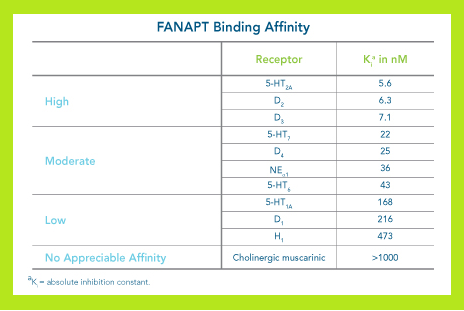
Those affinity constants on the right side don't tell you how much of each effect you'll get; they tell the order of binding. It tells you, for example, that the antihistamine effect will occur at a much higher dose than what's needed for the antipsychotic effect.
So what can we expect to happen with these numbers?
On the side it tells you about the 2 active metabolites. The P95 metabolite only shows affinity for serotonin and noradrenergic alpha1 receptors. What does that mean to psychiatry? Nothing: P95 doesn't cross the blood brain barrier. What does it mean to the rest of the body? Orthostatic hypotension.
See that 5HT7 early on in dosing? That receptor is involved in circadian rhythm. I don't know what that means yet, but as far as I know it is unique to this drug.
Slide 2: Pharmacodynamics
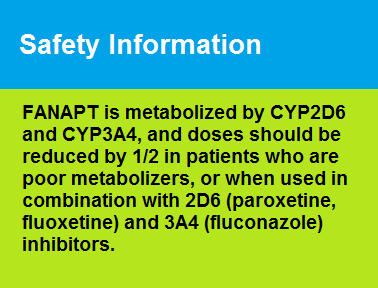
This slide is here to tell you that people who are poor metabolizers of CYP2D6 chemicals (e.g. Fanapt) will have higher blood levels. Clinically relevant people are 10% of caucasians and 5% of blacks none of whom you will ever be able to detect. Also relevant are drugs that inhibit 2D6 and 3A4 (Prozac, Paxil).
In drug drug interactions, the order of the drugs is very important. If you are already on Prozac, (hopefully) the doctor will simply observe that you needed less dose for the effect, regardless of whether he was even aware of the reason you needed less (the interaction.) But if you're on Fanapt already, and then get put on Prozac, your Fanapt levels will rise.
Slide 3: QTc
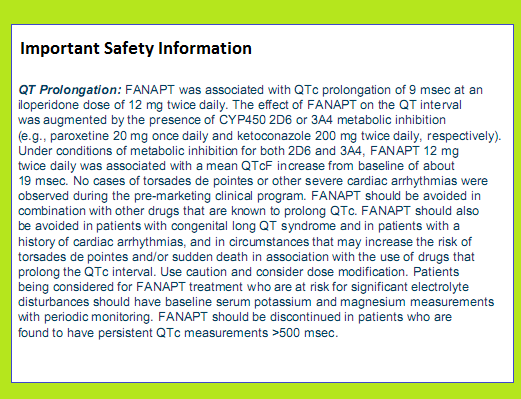
To put this in perspective: giving the max dose in one week, further elevated by the presence of Prozac or Paxil and ketoconazole, still resulted in an increase (19ms) that is less than the normal within-day variability (about 25ms).
The risk is fairly low.
Also, scan the slide, what does the FDA tell you? It tells you beware of people with cardiac arrhythmias; other drugs that also prolong QT; the metabolic effects of certain drugs (e.g. Paxil); and be aware of (low) potassium and magnesium.
It does not say to get an EKG. First, the average circadian variability is about 20-25ms. Second, a normal EKG today doesn't predict a normal EKG tomorrow, especially when drug levels are changing (and patients often get used to QT effects, so the prolongation lessens.) So unless you plan on doing daily EKGs, you risk information bias, i.e. letting today's normal EKG fool you into thinking all is well.
Better to be aware of the above listed factors, such as potassium, or to be aware of them. For example, what things lead to low potassium (which would increase the risk of QTc prolongation?) Diuretics, vomiting, etc.
Also be aware that order of drugs matters: a man on HCTZ for a year (potassium had time to normalize) who then gets Fanapt is at less risk than a man titrated to 24mg Fanapt who then gets HCTZ thrown on top.
Slide 4: Rationale For Active Control
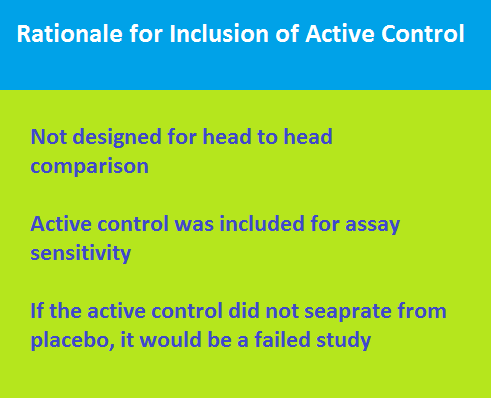
The slide appears before any other description of the study. Why?
This is not an "active comparator" study, it is an "active control" study. The purpose of the active control-- something you know reliably beats placebo in these kinds of studies-- is just a test to see whether the study "worked" (assay sensitivity.)
The reason you can't simply compare to the drug to your active control is twofold:
Slide 5: 4 Week Trial Design
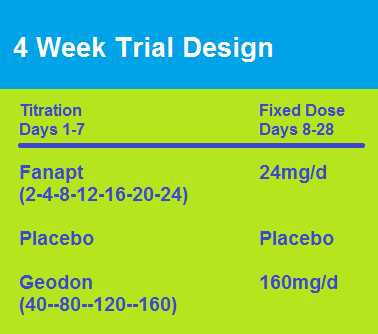
Why 4 weeks? Because dropouts in an 8 week study would decrease the power (e.g. sensitivity) of the study.
Why Geodon? To maintain the blinding: it's easy to tell if you're on Zyprexa (sedation) or Haldol (akathisia), but Geodon is milder.
"Geodon needs to be taken with food!" It was, they were careful, this is an inpatient study.
Observe that they got to 24mg of Fanapt and 160mg Geodon in 1 week. That will seem amazingly fast, or amazingly slow, depending on your background.
Slide 6: Primary Demographics
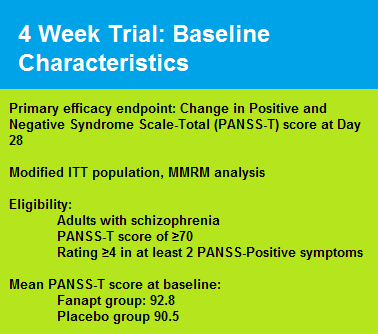
While you may be tempted to skip this, don't.
ITT= intent to treat. If a guy drops out after taking only one pill, what do you do? ITT says he is still part of the study. How do we deal with dropouts?
If you take their last observed score and carry it to the end, the overall average will appear sicker (and the drug may appear less effective than if they stayed on it.) Or, as here, you take into account the trajectory of the scores to infer where they would have gone if they stayed in the study. (More on LOCF, etc, here.)
Note that the primary efficacy measure is change on the PANSS scale: 30 items, scored 1 (absent) -7 (extreme). So a completely normal person scores a 30.
In order to be in the study, they needed to be sick enough to score above 70. And they were, at baseline, about 90.
Slide 7: 4 Week Trial Results
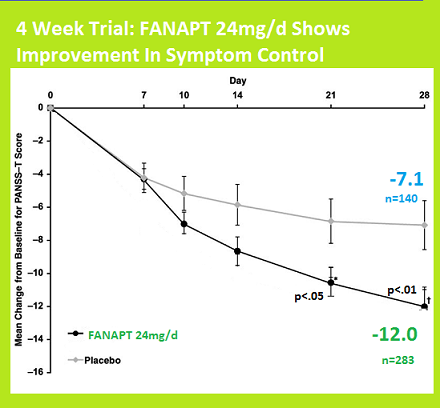
It's apparent that Fanapt beat placebo, -12 to -7.1 However, they started at a baseline of 90-92, so they ended up around 80. These patients are all still quite symptomatic-- they'd still be eligible to participate in the study again!
Note the lack of a Geodon curve. Where is it? I found it in the original study:
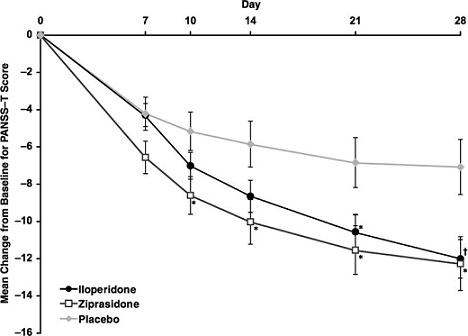
The study makes numerous comparisons with Geodon: efficacy measures, safety, side effects, etc. As well they should-- so why deliberately hide it in the promotional deck doesn't.
"Well, it shows that Geodon beat it, that's why they hide it." That's the reflexive answer. But it is the FDA that does not allow comparisons between drugs in promotional materials. They do it to prevent unwarranted comparisons, fine, but that's different than hiding the fact that it was already compared.
Note that Geodon 160mg was slightly better than Fanapt 24mg. While it's impossible to speculate, I will anyway: perhaps a little less, say, 120mg of Geodon, is about the same as 24mg Fanapt?
Slide 8: 6 Week Trial Design
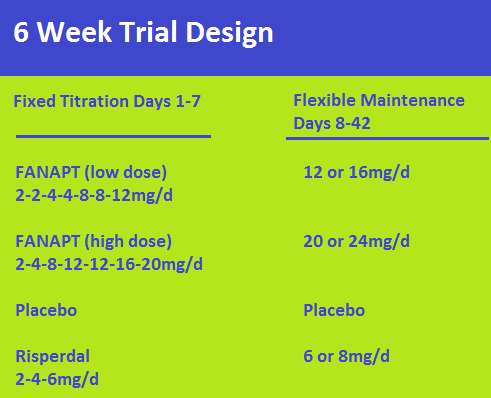
Similar to the 4 week trial, but note:
Why did I say 160mg of Geodon is about 3-4mg Risperdal? Because about the same number of D2 receptors are blocked at those doses. Since the 4 week study revealed a slight superiority of 160mg of Geodon over 24mg Fanapt, I'd expect 6mg Risperdal to blow it out of the water.
Slide 9: 6 Week Trial Results
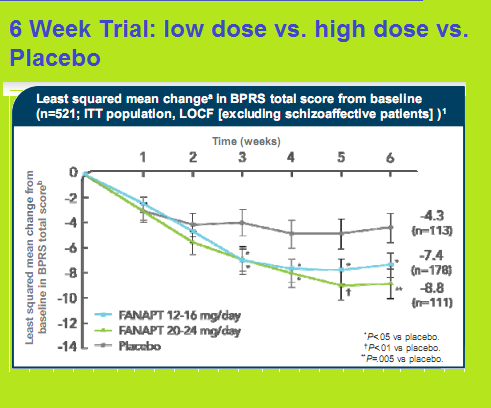
If the results here were easy to interpret, you wouldn't need me.
The change from baseline, -4.3, -7.4, and -8.8, are numerically smaller differences than those in the 4 week study because it's a different scale. This is the BPRS, not PANSS-- their mean baseline score was 55. However, the results are comparable.
Note that the low dose and high dose are both about the same until week 5, and even then there is only a slight benefit from a doubled dose. Stop at 12mg and assess; if you need more, go to 24mg, but don't rush to 24mg as per the FDA approved titration. As you will see later, the side effects at 24mg are greater than at 12mg.
Where's Risperdal? Have to go to the internet:
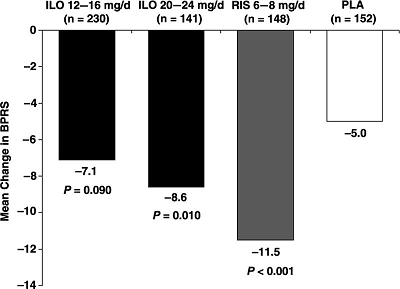
Risperdal 6mg, as predicted, was substantially "more"/better than 24mg Fanapt. Going by the conversion, we'd thus expect about 24mg Fanapt to be equivalent to 3mg of Risperdal to 120mg Geodon.
Now for something odd:
Look at the blue heading above the graph in the slide. "Excluding schizoaffective patients." Huh? In the original study (3005) schizophrenics and schizoaffectives both were permitted, assuming they were psychotic enough. When both were included, the low dose Fanapt (<16mg) failed vs. placebo. Only when the sample was restricted to schizophrenics did the low dose beat placebo.
This was a multi site, international study. Trouble was, none of the U.S. sites showed efficacy for either Fanapt or Risperdal. So all of the data you see here is very unamerican.
So why the poor results?
First, the Fanapt dose relative to Risperdal may be too low-- so low, in fact, that people drop out due to lack of efficacy. Indeed: 23% of Fanapt vs. 8% of Risperdalers dropped out from lack of efficacy, early on in the study (Americans want everything immediately.)
And so, secondly: this is an LOCF. When they drop out, they carry their early "sick" score to the end, making it look worse than it could have been. (2) So the 23% who dropped out early will drag the 6 week average up (sicker). When they went back and looked at the data using only patients who stayed on it for at least two weeks, the results of both doses and Risperdal were all comparable.
Moral: LOCF can kill a study if they drop out early.
To make sure, the FDA reanalyzed the data using MMRM (which doesn't use a last score but extrapolates from the trajectory of the scores):
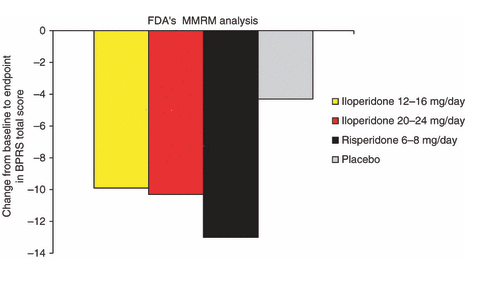
which here shows slightly better Risperdal efficacy, but again, it's 6-8mg, which is the inpatient equivalent of hitting them with a car.
Slide 10: Discontinuation Due To Adverse Events
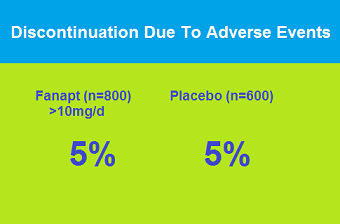
Awesome. However, every slide which reports FDA blessed data only reports from a specific time after randomization. So in this case, that's after Day 3. How many people dropped out in the first three days, "screening intolerability?" No idea. (NB: in long term maintenance trials, the randomization might not happen for months after patients are screened and stabilized, so those first few months would not be included in the overall data, e.g. this.)
Slide 11: Adverse Events
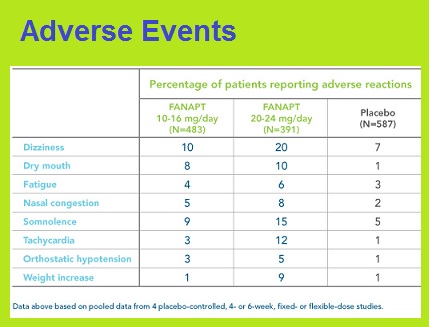
The problem with such slides is there's no way to organize it in your head. Is there a reason why dizziness doubles with dose, but dry mouth doesn't?
Go back to slide 1 and imagine the fountain model of receptor affinity. alpha1-- the receptor that causes orthostasis and probably "dizziness" and "somnolence" (and reflexive tachycardia) is a later receptor-- the higher you push the dose, the more of that effect you will get.
Slide 12: Extra Pyramidal Symptoms
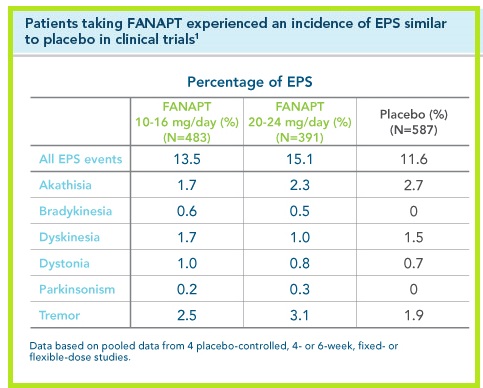
Rates of EPS appear to be low and don't increase with increased dose. Why? Go back to Slide 1, point 3: if/since EPS is related to Fanapt's affinity for blocking the D2 receptor, and its affinity lies somewhere between Zyprexa and Seroquel, then the EPS rates should also be somewhere between Zyprexa and Seroquel, i.e. very low. Also, note slide 9: Fanapt 20-24mg will be about equivalent to 10mg Zyprexa or 3mg Risperdal.
Slide 13: Prolactin levels
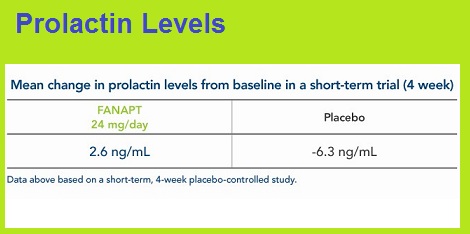
As above, D2 affinities predict prolactin levels somewhere comparable to Zyprexa, i.e. low. Rigorously, it should be noted that this is only data in the first month, not after a year of exposure; but if the affinity is weak enough that it only transiently binds to the receptor-- and thus only transiently results in prolactin surges, then there will be less overall exposure.
Extra credit: "If prolactin is related to D2 blockade and affinity at the D2 receptor, than why does Haldol cause less hyperprolactinemia than Risperdal, even though Rispderal;s affinity is less than Haldol's?
Most antipsychotics easily cross the blood brain barrier. Risperdal doesn't (well). The pituitary is outside of the blood brain barrier. In order to get adequate penetration into the brain, a higher dose of Risperdal is used than would be if it could easily pass. So outside the BBB, the pituitary is exposed to much more Risperdal than Haldol, even though they block comparable amounts of D2 receptors inside the brain.
Slide 14, 15: Clinically significant weight gain and Mean change in weight
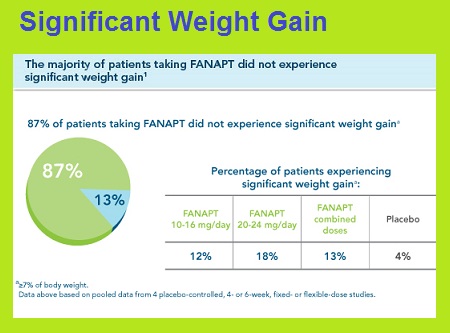
A tricky slide. It shows that 12-18% of patients have "significant weight gain," defined as >7% of body weight. So about 10-15 lbs.
However,

If the mean weight change is 4.6 lbs, and 15% of them gained more than 10lbs, then that means that some people gained no weight, and may even have lost weight. The trick is to distinguish those people.
Can the people at risk for greatest increase be predicted? We only have the lessons of Zyprexa:
1. Those who gain weight do it early; what happens in the first three weeks are predictive
2. The main dietary intervention should be reducing carbs/sugars, especially fructose, not total calories.
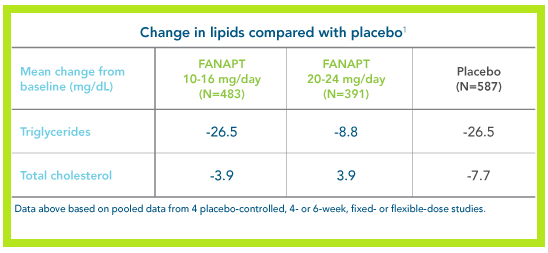
Some of this material overlaps with the otherst, but I've repeated it here so it could stand alone.
I made these slides mostly from memory or from the PI using MS Paint. They appear different/more professional in the promotional materials, I can assure you.
-------
First, an apocryphal story: Fanapt was named after the Greek word "phaneros" which means to manifest, to make obvious. It was done because the CEO/Founder of Vanda Pharmaceuticals was Greek (Polymeropoulos.)
Slide 1: Pharmacology

Those affinity constants on the right side don't tell you how much of each effect you'll get; they tell the order of binding. It tells you, for example, that the antihistamine effect will occur at a much higher dose than what's needed for the antipsychotic effect.
So what can we expect to happen with these numbers?
- At the lower doses, it will act a lot like Risperdal: selective and relatively equal 5HT2a and D2 blockade (Ki between 0.1 and 7nM).
- However, it has a1 blockade-- so I expect to see more orthostatic hypotension/sedation than Risperdal, especially as the dose is increased.
- Based on the in vitro affinities shown here (which are often poor proxies for in vivo, but I can only work with what I have)-- I'd expect EPS, prolactin, TD, akathisia rates to be superior to Risperdal, comparable to Zyprexa, and worse than Seroquel.
On the side it tells you about the 2 active metabolites. The P95 metabolite only shows affinity for serotonin and noradrenergic alpha1 receptors. What does that mean to psychiatry? Nothing: P95 doesn't cross the blood brain barrier. What does it mean to the rest of the body? Orthostatic hypotension.
See that 5HT7 early on in dosing? That receptor is involved in circadian rhythm. I don't know what that means yet, but as far as I know it is unique to this drug.
Slide 2: Pharmacodynamics

This slide is here to tell you that people who are poor metabolizers of CYP2D6 chemicals (e.g. Fanapt) will have higher blood levels. Clinically relevant people are 10% of caucasians and 5% of blacks none of whom you will ever be able to detect. Also relevant are drugs that inhibit 2D6 and 3A4 (Prozac, Paxil).
In drug drug interactions, the order of the drugs is very important. If you are already on Prozac, (hopefully) the doctor will simply observe that you needed less dose for the effect, regardless of whether he was even aware of the reason you needed less (the interaction.) But if you're on Fanapt already, and then get put on Prozac, your Fanapt levels will rise.
Slide 3: QTc

To put this in perspective: giving the max dose in one week, further elevated by the presence of Prozac or Paxil and ketoconazole, still resulted in an increase (19ms) that is less than the normal within-day variability (about 25ms).
The risk is fairly low.
Also, scan the slide, what does the FDA tell you? It tells you beware of people with cardiac arrhythmias; other drugs that also prolong QT; the metabolic effects of certain drugs (e.g. Paxil); and be aware of (low) potassium and magnesium.
It does not say to get an EKG. First, the average circadian variability is about 20-25ms. Second, a normal EKG today doesn't predict a normal EKG tomorrow, especially when drug levels are changing (and patients often get used to QT effects, so the prolongation lessens.) So unless you plan on doing daily EKGs, you risk information bias, i.e. letting today's normal EKG fool you into thinking all is well.
Better to be aware of the above listed factors, such as potassium, or to be aware of them. For example, what things lead to low potassium (which would increase the risk of QTc prolongation?) Diuretics, vomiting, etc.
Also be aware that order of drugs matters: a man on HCTZ for a year (potassium had time to normalize) who then gets Fanapt is at less risk than a man titrated to 24mg Fanapt who then gets HCTZ thrown on top.
Slide 4: Rationale For Active Control

The slide appears before any other description of the study. Why?
This is not an "active comparator" study, it is an "active control" study. The purpose of the active control-- something you know reliably beats placebo in these kinds of studies-- is just a test to see whether the study "worked" (assay sensitivity.)
- If the drug that usually works fails here, then likely the study itself was a bust.
- If it works but Fanapt doesn't, then Fanapt is a bust.
The reason you can't simply compare to the drug to your active control is twofold:
- there may not be enough patients in the active control arm-- its results may come out worse than ordinarily. (if it fails in one guy, but you only have two guys...)
- the dose of the active control might be enough to usually beat placebo, but maybe not enough to beat 24mg of Fanapt. If you run a trial of 30mg Zyprexa (a lot) vs. 1mg Risperdal (a little) vs. placebo, both would beat placebo; but could you really infer that Zyprexa is a more efficacious drug than Risperdal?
Slide 5: 4 Week Trial Design

Why 4 weeks? Because dropouts in an 8 week study would decrease the power (e.g. sensitivity) of the study.
Why Geodon? To maintain the blinding: it's easy to tell if you're on Zyprexa (sedation) or Haldol (akathisia), but Geodon is milder.
"Geodon needs to be taken with food!" It was, they were careful, this is an inpatient study.
Observe that they got to 24mg of Fanapt and 160mg Geodon in 1 week. That will seem amazingly fast, or amazingly slow, depending on your background.
Slide 6: Primary Demographics

While you may be tempted to skip this, don't.
ITT= intent to treat. If a guy drops out after taking only one pill, what do you do? ITT says he is still part of the study. How do we deal with dropouts?
If you take their last observed score and carry it to the end, the overall average will appear sicker (and the drug may appear less effective than if they stayed on it.) Or, as here, you take into account the trajectory of the scores to infer where they would have gone if they stayed in the study. (More on LOCF, etc, here.)
Note that the primary efficacy measure is change on the PANSS scale: 30 items, scored 1 (absent) -7 (extreme). So a completely normal person scores a 30.
In order to be in the study, they needed to be sick enough to score above 70. And they were, at baseline, about 90.
Slide 7: 4 Week Trial Results

It's apparent that Fanapt beat placebo, -12 to -7.1 However, they started at a baseline of 90-92, so they ended up around 80. These patients are all still quite symptomatic-- they'd still be eligible to participate in the study again!
Note the lack of a Geodon curve. Where is it? I found it in the original study:

The study makes numerous comparisons with Geodon: efficacy measures, safety, side effects, etc. As well they should-- so why deliberately hide it in the promotional deck doesn't.
"Well, it shows that Geodon beat it, that's why they hide it." That's the reflexive answer. But it is the FDA that does not allow comparisons between drugs in promotional materials. They do it to prevent unwarranted comparisons, fine, but that's different than hiding the fact that it was already compared.
Note that Geodon 160mg was slightly better than Fanapt 24mg. While it's impossible to speculate, I will anyway: perhaps a little less, say, 120mg of Geodon, is about the same as 24mg Fanapt?
Slide 8: 6 Week Trial Design

Similar to the 4 week trial, but note:
- in the 4 week trial, patients were on 24mg/d by the end of week 1. So these doses are either lower (high dose) or considerably lower (low dose)
- the active control is Risperdal. It took a week to get to 160mg of Geodon, which is about 3-4mg Risperdal-- in this study, patients were on 6mg Risperdal by the third day.
Why did I say 160mg of Geodon is about 3-4mg Risperdal? Because about the same number of D2 receptors are blocked at those doses. Since the 4 week study revealed a slight superiority of 160mg of Geodon over 24mg Fanapt, I'd expect 6mg Risperdal to blow it out of the water.
Slide 9: 6 Week Trial Results

If the results here were easy to interpret, you wouldn't need me.
The change from baseline, -4.3, -7.4, and -8.8, are numerically smaller differences than those in the 4 week study because it's a different scale. This is the BPRS, not PANSS-- their mean baseline score was 55. However, the results are comparable.
Note that the low dose and high dose are both about the same until week 5, and even then there is only a slight benefit from a doubled dose. Stop at 12mg and assess; if you need more, go to 24mg, but don't rush to 24mg as per the FDA approved titration. As you will see later, the side effects at 24mg are greater than at 12mg.
Where's Risperdal? Have to go to the internet:

Risperdal 6mg, as predicted, was substantially "more"/better than 24mg Fanapt. Going by the conversion, we'd thus expect about 24mg Fanapt to be equivalent to 3mg of Risperdal to 120mg Geodon.
Now for something odd:
Look at the blue heading above the graph in the slide. "Excluding schizoaffective patients." Huh? In the original study (3005) schizophrenics and schizoaffectives both were permitted, assuming they were psychotic enough. When both were included, the low dose Fanapt (<16mg) failed vs. placebo. Only when the sample was restricted to schizophrenics did the low dose beat placebo.
This was a multi site, international study. Trouble was, none of the U.S. sites showed efficacy for either Fanapt or Risperdal. So all of the data you see here is very unamerican.
So why the poor results?
First, the Fanapt dose relative to Risperdal may be too low-- so low, in fact, that people drop out due to lack of efficacy. Indeed: 23% of Fanapt vs. 8% of Risperdalers dropped out from lack of efficacy, early on in the study (Americans want everything immediately.)
And so, secondly: this is an LOCF. When they drop out, they carry their early "sick" score to the end, making it look worse than it could have been. (2) So the 23% who dropped out early will drag the 6 week average up (sicker). When they went back and looked at the data using only patients who stayed on it for at least two weeks, the results of both doses and Risperdal were all comparable.
Moral: LOCF can kill a study if they drop out early.
To make sure, the FDA reanalyzed the data using MMRM (which doesn't use a last score but extrapolates from the trajectory of the scores):

which here shows slightly better Risperdal efficacy, but again, it's 6-8mg, which is the inpatient equivalent of hitting them with a car.
Slide 10: Discontinuation Due To Adverse Events

Awesome. However, every slide which reports FDA blessed data only reports from a specific time after randomization. So in this case, that's after Day 3. How many people dropped out in the first three days, "screening intolerability?" No idea. (NB: in long term maintenance trials, the randomization might not happen for months after patients are screened and stabilized, so those first few months would not be included in the overall data, e.g. this.)
Slide 11: Adverse Events

The problem with such slides is there's no way to organize it in your head. Is there a reason why dizziness doubles with dose, but dry mouth doesn't?
Go back to slide 1 and imagine the fountain model of receptor affinity. alpha1-- the receptor that causes orthostasis and probably "dizziness" and "somnolence" (and reflexive tachycardia) is a later receptor-- the higher you push the dose, the more of that effect you will get.
Slide 12: Extra Pyramidal Symptoms

Rates of EPS appear to be low and don't increase with increased dose. Why? Go back to Slide 1, point 3: if/since EPS is related to Fanapt's affinity for blocking the D2 receptor, and its affinity lies somewhere between Zyprexa and Seroquel, then the EPS rates should also be somewhere between Zyprexa and Seroquel, i.e. very low. Also, note slide 9: Fanapt 20-24mg will be about equivalent to 10mg Zyprexa or 3mg Risperdal.
Slide 13: Prolactin levels

As above, D2 affinities predict prolactin levels somewhere comparable to Zyprexa, i.e. low. Rigorously, it should be noted that this is only data in the first month, not after a year of exposure; but if the affinity is weak enough that it only transiently binds to the receptor-- and thus only transiently results in prolactin surges, then there will be less overall exposure.
Extra credit: "If prolactin is related to D2 blockade and affinity at the D2 receptor, than why does Haldol cause less hyperprolactinemia than Risperdal, even though Rispderal;s affinity is less than Haldol's?
Most antipsychotics easily cross the blood brain barrier. Risperdal doesn't (well). The pituitary is outside of the blood brain barrier. In order to get adequate penetration into the brain, a higher dose of Risperdal is used than would be if it could easily pass. So outside the BBB, the pituitary is exposed to much more Risperdal than Haldol, even though they block comparable amounts of D2 receptors inside the brain.
Slide 14, 15: Clinically significant weight gain and Mean change in weight

A tricky slide. It shows that 12-18% of patients have "significant weight gain," defined as >7% of body weight. So about 10-15 lbs.
However,

If the mean weight change is 4.6 lbs, and 15% of them gained more than 10lbs, then that means that some people gained no weight, and may even have lost weight. The trick is to distinguish those people.
Can the people at risk for greatest increase be predicted? We only have the lessons of Zyprexa:
1. Those who gain weight do it early; what happens in the first three weeks are predictive
2. The main dietary intervention should be reducing carbs/sugars, especially fructose, not total calories.
Slide 16: Lipid Profile

The point of the slide is that Fanapt doesn't affect TG or cholesterol much from placebo.
However:
1. This is short term, one month. If the weight change is mechanistically like Zyprexa then it should show up in a month. But if it is like Risperdal, slower, and possibly tied to prolactin elevation (the effect of which can take months- a year) then this doesn't tell you much.
2. Why does the placebo TG have a negative? In other words, why does putting them on placebo make the TG go down? Recall the study design: real patients are taken off their meds, and randomized to Fanapt or placebo. Maybe taking them off Zyprexa is what did it? Nope. Most acute (vs. maintenance) studies are done inpatient; so patients are taken from the outside, where they eat terrible diets and smoke packs of cigarettes, and moved inpatient where they eat comparatively healthier food, and smoke much less.
----
Addendum 6/1/11:
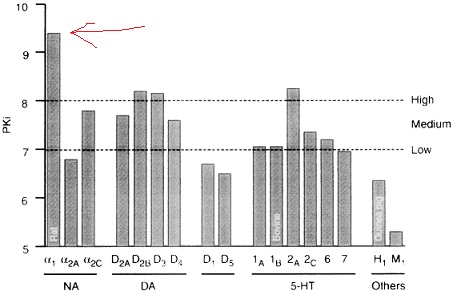
This graph shows the in-vitro affinities of Fanapt from a study in 2001. Biggest bar is the highest affinity, which in this case is alpha1. Yet in the pharmacology slide:
 alpha1 is way down. The slide suggests that alpha1 blockade-- orthostatic hypotension-- happens at higher doses. Yet the graph above suggests that it should be the very first thing out of the box.
alpha1 is way down. The slide suggests that alpha1 blockade-- orthostatic hypotension-- happens at higher doses. Yet the graph above suggests that it should be the very first thing out of the box.
Turns out... Novartis made a mistake with the decimal point. That's not 36 nM, but 0.36 nM. Here's the new slide:
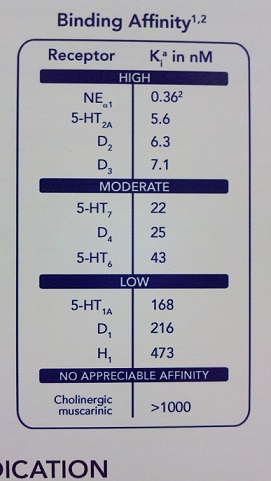
That is a gigantic oops. First, it means that orthostasis comes early and fast, which is bad enough. It also means you can't rush the dose titration, which is what docs want to do in severe, acute situations.
But it hurts the credibility of the company. Yes, it's a mistake, a "small" one in the sense that it could be missed, but if a trader bought something at 100x more or less than it was worth. it would be labeled a catastrophe. Even accidentally overstating the clinical trial data is easier to apologize for because we all understand that clinical data is "in progress." But pharmacology is supposed to be a drug's true identity, outside of marketing, outside of spin.
And the problem is that in order for Novartis to explain this in any way other than to say, "we made a gigantic mistake," it must make absorb pharmacology into marketing; instead of merely saying, "yes, we have a lot of alpha1 blockade, just go slow and the patient will not notice" they have to change reality: "well that's not really a big difference..."
You might also enjoy:
Deconstructing A Promotional Slide Deck: Geodon
However:
1. This is short term, one month. If the weight change is mechanistically like Zyprexa then it should show up in a month. But if it is like Risperdal, slower, and possibly tied to prolactin elevation (the effect of which can take months- a year) then this doesn't tell you much.
2. Why does the placebo TG have a negative? In other words, why does putting them on placebo make the TG go down? Recall the study design: real patients are taken off their meds, and randomized to Fanapt or placebo. Maybe taking them off Zyprexa is what did it? Nope. Most acute (vs. maintenance) studies are done inpatient; so patients are taken from the outside, where they eat terrible diets and smoke packs of cigarettes, and moved inpatient where they eat comparatively healthier food, and smoke much less.
----
Addendum 6/1/11:

This graph shows the in-vitro affinities of Fanapt from a study in 2001. Biggest bar is the highest affinity, which in this case is alpha1. Yet in the pharmacology slide:
 alpha1 is way down. The slide suggests that alpha1 blockade-- orthostatic hypotension-- happens at higher doses. Yet the graph above suggests that it should be the very first thing out of the box.
alpha1 is way down. The slide suggests that alpha1 blockade-- orthostatic hypotension-- happens at higher doses. Yet the graph above suggests that it should be the very first thing out of the box.Turns out... Novartis made a mistake with the decimal point. That's not 36 nM, but 0.36 nM. Here's the new slide:

That is a gigantic oops. First, it means that orthostasis comes early and fast, which is bad enough. It also means you can't rush the dose titration, which is what docs want to do in severe, acute situations.
But it hurts the credibility of the company. Yes, it's a mistake, a "small" one in the sense that it could be missed, but if a trader bought something at 100x more or less than it was worth. it would be labeled a catastrophe. Even accidentally overstating the clinical trial data is easier to apologize for because we all understand that clinical data is "in progress." But pharmacology is supposed to be a drug's true identity, outside of marketing, outside of spin.
And the problem is that in order for Novartis to explain this in any way other than to say, "we made a gigantic mistake," it must make absorb pharmacology into marketing; instead of merely saying, "yes, we have a lot of alpha1 blockade, just go slow and the patient will not notice" they have to change reality: "well that's not really a big difference..."
You might also enjoy:
Deconstructing A Promotional Slide Deck: Geodon
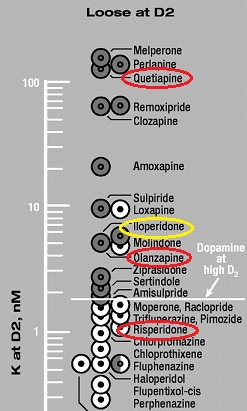 (from
(from
31 Comments